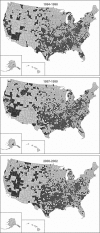Trends in one-year recurrent ischemic stroke among the elderly in the USA: 1994-2002
- PMID: 20881382
- PMCID: PMC2978738
- DOI: 10.1159/000319028
Trends in one-year recurrent ischemic stroke among the elderly in the USA: 1994-2002
Abstract
Background and purpose: Of the 795,000 strokes occurring in the USA each year, over 20% are recurrent events. Little is known about how the rates of recurrent stroke in the country have changed over time. Our objective was to determine national trends in 1-year recurrent ischemic stroke rates by US county among the elderly from 1994 to 2002.
Methods: One-year recurrent stroke rates following incident ischemic stroke (ICD-9 433, 434, 436) among all fee-for-service Medicare beneficiaries were determined by US county for 1994-1996, 1997-1999, and 2000-2002. Bayesian spatiotemporal Poisson modeling was used to determine county-specific trends in recurrent stroke rates over time with risk adjustment for demographics, medical history and comorbid conditions.
Results: The analysis included more than 2.5 million beneficiaries (56% women; mean age: 78 years; 87% white; n = 957,933 for 1994-1996; n = 838,330 for 1996-1999; n = 895,916 for 2000-2002) aggregated to all 3,118 US counties. After adjustment for changing patient demographics and comorbidities, there was a 4.5% decrease in recurrent stroke rates from 1994-1996 (13.2%) to 2000-2002 (12.6%; p for trend <0.0001). The geographic and temporal patterns were not uniform; the recurrent stroke rates decreased within sections of the Southeast (the 'stroke belt'), but increased in counties in the middle and western sections of the USA.
Conclusions: The overall recurrent ischemic stroke rates declined by almost 5% from 1994 to 2002, but temporal patterns varied markedly by region. Additional research is needed to identify the reasons for this geographic disparity.
Copyright © 2010 S. Karger AG, Basel.
Figures


Similar articles
-
Trends in 1-Year Recurrent Ischemic Stroke in the US Medicare Fee-for-Service Population.Stroke. 2022 Nov;53(11):3338-3347. doi: 10.1161/STROKEAHA.122.039438. Epub 2022 Oct 10. Stroke. 2022. PMID: 36214126 Free PMC article.
-
Geographic variation in one-year recurrent ischemic stroke rates for elderly Medicare beneficiaries in the USA.Neuroepidemiology. 2010;34(2):123-9. doi: 10.1159/000274804. Epub 2010 Jan 13. Neuroepidemiology. 2010. PMID: 20068358 Free PMC article.
-
Carotid Endarterectomy and Carotid Artery Stenting in the US Medicare Population, 1999-2014.JAMA. 2017 Sep 19;318(11):1035-1046. doi: 10.1001/jama.2017.12882. JAMA. 2017. PMID: 28975306 Free PMC article.
-
Use of diagnostic subtraction angiography for ischemic stroke (US DUTCH study) Regional variation and time-trend among medicare beneficiaries.J Stroke Cerebrovasc Dis. 2025 Jan;34(1):108108. doi: 10.1016/j.jstrokecerebrovasdis.2024.108108. Epub 2024 Nov 19. J Stroke Cerebrovasc Dis. 2025. PMID: 39571663
-
Temporal trends in patient characteristics and outcomes among Medicare beneficiaries undergoing primary prevention implantable cardioverter-defibrillator placement in the United States, 2006-2010. Results from the National Cardiovascular Data Registry's Implantable Cardioverter-Defibrillator Registry.Circulation. 2014 Sep 2;130(10):845-53. doi: 10.1161/CIRCULATIONAHA.114.008653. Epub 2014 Aug 5. Circulation. 2014. PMID: 25095884
Cited by
-
Stroke epidemiology: advancing our understanding of disease mechanism and therapy.Neurotherapeutics. 2011 Jul;8(3):319-29. doi: 10.1007/s13311-011-0053-1. Neurotherapeutics. 2011. PMID: 21691873 Free PMC article. Review.
-
Heart Disease and Stroke Statistics-2017 Update: A Report From the American Heart Association.Circulation. 2017 Mar 7;135(10):e146-e603. doi: 10.1161/CIR.0000000000000485. Epub 2017 Jan 25. Circulation. 2017. PMID: 28122885 Free PMC article. Review. No abstract available.
-
Spatiotemporal and Demographic Trends and Disparities in Cardiovascular Disease Among Older Adults in the United States Based on 181 Million Hospitalization Records.J Am Heart Assoc. 2019 Nov 5;8(21):e012727. doi: 10.1161/JAHA.119.012727. Epub 2019 Oct 29. J Am Heart Assoc. 2019. PMID: 31658854 Free PMC article.
-
Quantifying and addressing persistent stroke disparities in Hispanics.Ann Neurol. 2013 Dec;74(6):759-61. doi: 10.1002/ana.24025. Ann Neurol. 2013. PMID: 24114772 Free PMC article. No abstract available.
-
Expression of miR-1-3p, miR-16-5p and miR-122-5p as Possible Risk Factors of Secondary Cardiovascular Events.Biomedicines. 2021 Aug 20;9(8):1055. doi: 10.3390/biomedicines9081055. Biomedicines. 2021. PMID: 34440258 Free PMC article.
References
-
- Lloyd-Jones D, Adams R, Carnethon M, de Simone G, Ferguson TB, Flegal K, Ford E, Furie K, Go A, Greenlund K, Haase N, Hailpern S, Ho M, Howard V, Kissela B, Kittner S, Lackland D, Lisabeth L, Marelli A, McDermott M, Meigs J, Mozaffarian D, Nichol G, O'Donnell C, Roger V, Rosamond W, Sacco R, Sorlie P, Stafford R, Steinberger J, Thom T, Wasserthiel-Smoller S, Wong N, Wylie-Rosett J, Hong Y. Heart disease and stroke statistics – 2009 update: a report from the American Heart Association Statistics Committee and Stroke Statistics Subcommittee. Circulation. 2009;119:e21–e181. - PubMed
-
- Sacco RL, Adams R, Albers G, Alberts MJ, Benavente O, Furie K, Goldstein LB, Gorelick P, Halperin J, Harbaugh R, Johnston SC, Katzan I, Kelly-Hayes M, Kenton EJ, Marks M, Schwamm LH, Tomsick T. Guidelines for prevention of stroke in patients with ischemic stroke or transient ischemic attack: a statement for healthcare professionals from the American Heart Association/American Stroke Association Council on Stroke. Co-sponsored by the Council on Cardiovascular Radiology and Intervention. The American Academy of Neurology affirms the value of this guideline. Stroke. 2006;37:577–617. - PubMed
-
- Adams HP, Jr, Adams RJ, Brott T, del Zoppo GJ, Furlan A, Goldstein LB, Grubb RL, Higashida R, Kidwell C, Kwiatkowski TG, Marler JR, Hademenos GJ. Guidelines for the early management of patients with ischemic stroke: a scientific statement from the Stroke Council of the American Stroke Association. Stroke. 2003;34:1056–1083. - PubMed
-
- Holloway RG, Benesch C, Rush SR. Stroke prevention: narrowing the evidence-practice gap. Neurology. 2000;54:1899–1906. - PubMed
Publication types
MeSH terms
Grants and funding
LinkOut - more resources
Full Text Sources
Other Literature Sources
Medical

